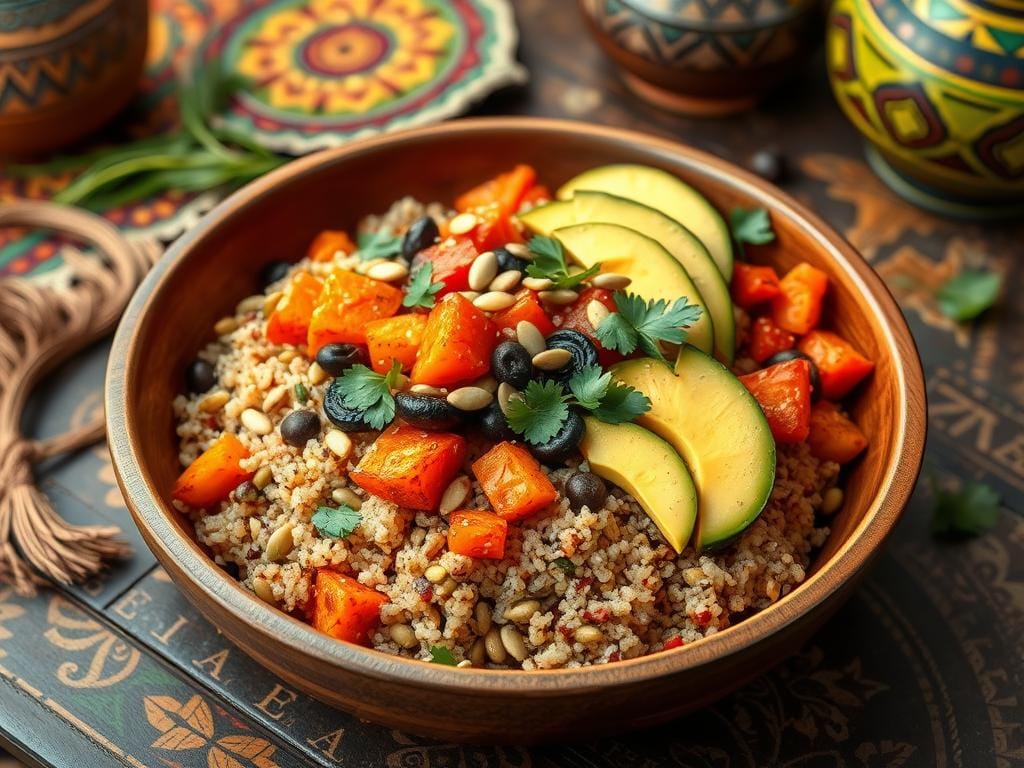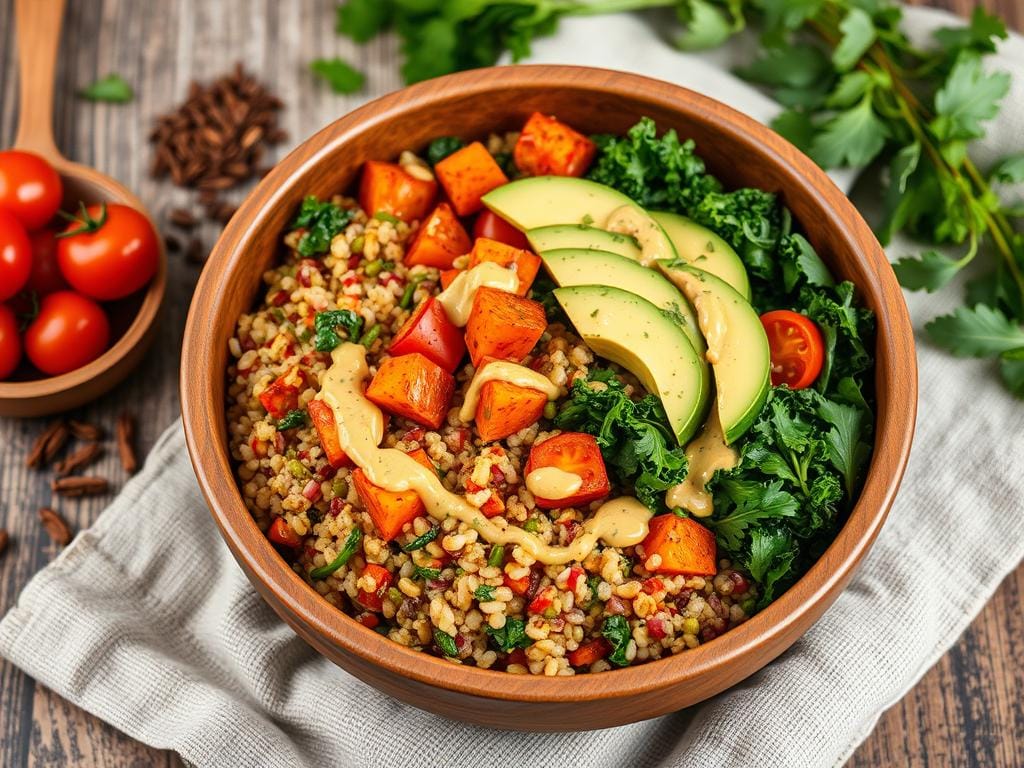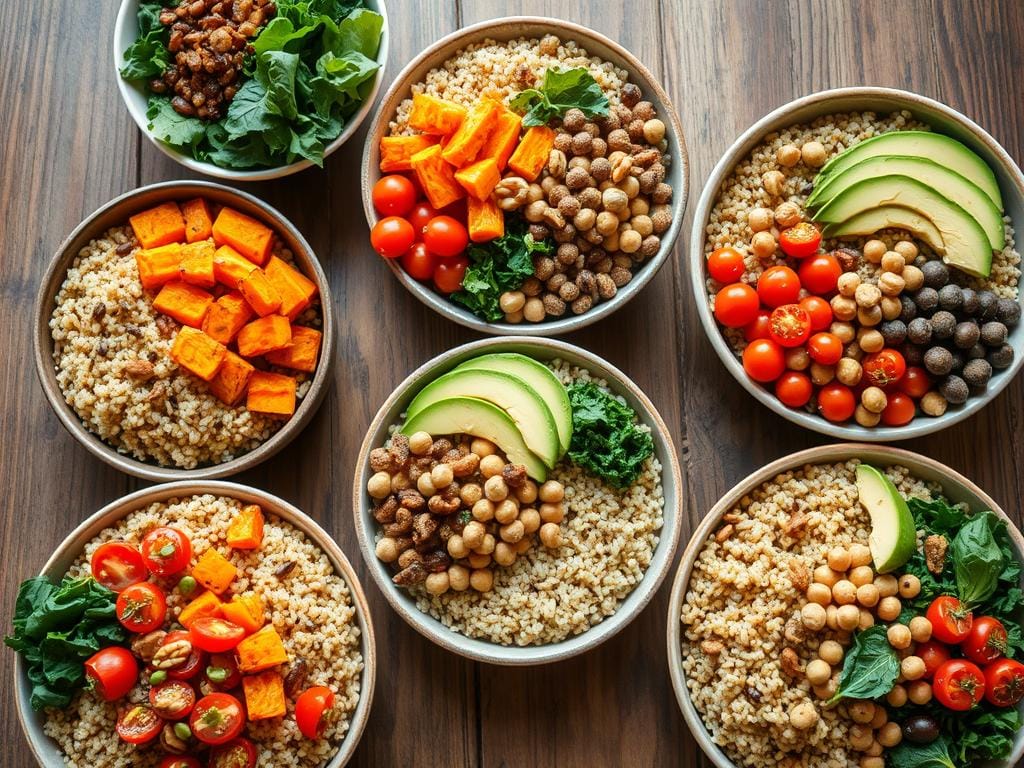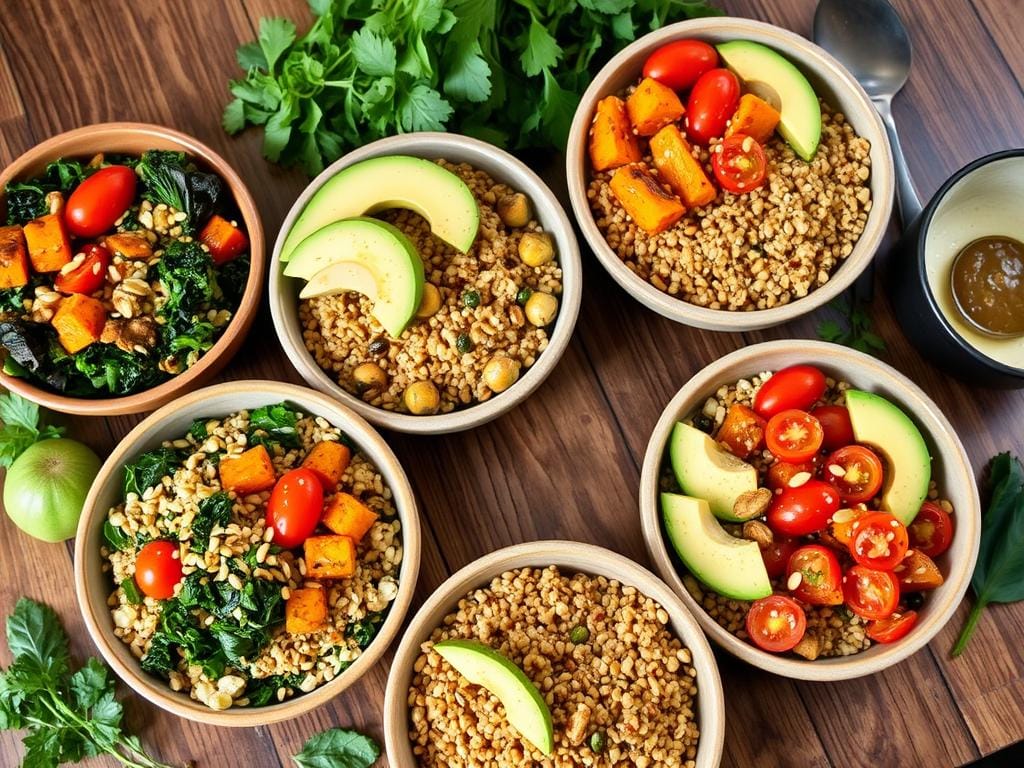Welcome to the vibrant world of african grain bowls. Here, tradition meets nutrition and flavor. You can explore a variety of grain bowl recipes to find your favorite. These bowls are more than just a meal; they’re an experience that blends African heritage with a healthy diet.
Looking for a new breakfast, lunch, or dinner idea? African grain bowls are perfect. They’re easy to make, customizable, and full of nutrients. You can mix and match ingredients to create your own healthy bowls.
Key Takeaways
- African grain bowls offer a balanced mix of grains, vegetables, and proteins, making them a nutritious meal option.
- You can customize your african grain bowls to suit your taste preferences and dietary needs.
- Healthy grain bowls are easy to make and can be prepared for any meal of the day.
- African grain bowls are a great way to experience the richness of African heritage and culture.
- Grain bowl recipe can be varied to include different ingredients and flavors.
- African grain bowls are a perfect choice for anyone looking for a healthy and flavorful meal option.
Understanding the Rich Heritage of African Grain Bowls
African cuisine is incredibly diverse, with different regions having their unique grains and cooking methods. You can explore the various african cuisine options to find inspiration for your next meal. The heritage of African grain bowls is as rich as the continent itself, bringing people together in a shared experience of food and community.
When it comes to creating a nutritious grain bowl, you can draw from the traditional grains and cooking techniques of African cuisine. From the hearty jollof rice of West Africa to the flavorful injera of Ethiopia, each region boasts its own unique flavors and ingredients. This diversity is what makes African-inspired bowls so exciting, as you can experiment with different grains, spices, and vegetables to create your perfect bowl.
These grains are not only delicious but also packed with nutrients, making them a great base for a healthy andnutritious grain bowl. By exploring the rich heritage of African grain bowls, you can gain a deeper appreciation for the cultural significance of these dishes and inspire your own creativity in the kitchen.
As you dive into the world of African grain bowls, you’ll discover the cultural significance of communal bowls and the importance of sharing meals with others. This sense of community is at the heart of African cuisine, and it’s what makes african-inspired bowls so special. Whether you’re cooking for yourself or for a crowd, you can create a delicious and nutritious meal that brings people together and celebrates the rich heritage of African grain bowls.
Essential Ingredients for Authentic African Grain Bowls
To make an authentic African grain bowl, start with whole grains. Use brown rice, quinoa, and millet as your base. These grains are not only tasty but also full of nutrients. They make a great start for your easy grain bowl ideas.
Then, add lean proteins like chicken, fish, and beans. These add flavor and are good for you. Don’t forget colorful veggies like leafy greens and bell peppers. They boost the bowl’s health and look.
Some key ingredients for your authentic African grain bowl are:
- Whole grains like brown rice, quinoa, and millet
- Lean proteins like chicken, fish, and beans
- Colorful vegetables like leafy greens and bell peppers
With these, you can make a bowl that’s tasty, healthy, and true to its roots. Be creative and enjoy trying new combinations. Find your favorite easy grain bowl ideas this way.

By using these key ingredients, you’ll create a delicious and nutritious bowl. It’s a true authentic African grain bowl experience.
The Nutritional Power of Traditional African Grains
Healthy grain bowls are a great choice, and african grain bowls are even better. They are packed with nutrients, making them perfect for a healthy diet. These grains are full of fiber, which helps with digestion and keeps you full. They also have a lot of protein, which is good for your muscles.
Some of the key health benefits of these grains include:
- High fiber content, which can help lower cholesterol levels and regulate blood sugar
- Rich in protein, making them an excellent option for vegetarians and vegans
- Good source of micronutrients like iron, zinc, and B vitamins
Adding african grain bowls to your meals can greatly improve your health. These grains are not only good for you but also taste great and can be used in many ways. They are perfect for a quick breakfast or a healthy lunch.
Traditional African grains are also full of antioxidants and have anti-inflammatory properties. They can help protect against heart disease, diabetes, and some cancers. With their health benefits and tasty flavor, it’s easy to see why african grain bowls are becoming more popular.
Building Your Perfect African Grain Bowl
To make a tasty and healthy grain bowl recipe, mix different ingredients. Start with a base grain like brown rice, quinoa, or farro. Then, pick a protein that goes well with your grain, such as chicken, salmon, or tofu.
After that, add various vegetables for texture and taste. You can use roasted sweet potatoes, sautéed spinach, and grilled bell peppers. The goal is to find the right mix of flavors and textures in your african-inspired bowls.
Here are some tips to help you build your perfect african grain bowl:
- Choose a base grain that you enjoy
- Select a protein source that complements your grain
- Add a variety of vegetables for balance and flavor
- Top with your favorite african-inspired sauce or seasoning

African grain bowls are all about being flexible. Feel free to try out different ingredients and flavors until you hit the mark. With a bit of creativity and practice, you can craft a delicious and nutritious grain bowl that matches your taste.
Mastering the Art of Grain Preparation
To make tasty african grain bowls, knowing how to prepare grains is key. Each grain needs a special way to get the right texture. With some practice, you’ll be a pro at preparing grains, making your grain bowl ideas easy to do.
Preparing grains involves soaking, cooking, and seasoning them. Proper soaking techniques can cut down cooking time and make grains easier to digest. For example, brown rice and quinoa soak well, but millet and teff might not need it.
Proper Soaking Techniques
- Soak grains in water for the recommended time to reduce phytic acid and improve nutrient absorption.
- Use a ratio of 1:2 for grains to water to ensure proper hydration.
- Change the water periodically to prevent fermentation and bacterial growth.
Cooking Methods and Times
Cooking grains can be tricky, but with the right methods, you can get the perfect texture. This methods differ based on the grain type, and cooking times vary from a few minutes to hours. For instance, quinoa cooks fast, while brown rice takes longer.
By mastering grain preparation, you can make many african grain bowls that are both healthy and tasty. With these tips, you’ll become a grain preparation expert. Your grain bowl ideas will soon be a favorite in your kitchen.
Complementary Vegetables and Proteins
Creating a tasty and healthy dish like african cuisine grain bowls requires careful choice of vegetables and proteins. You can add roasted sweet potatoes, sautéed spinach, and grilled bell peppers to your bowls. These vegetables bring flavor and nutrients.
Adding proteins like grilled chicken, chickpeas, or black beans is also key. They enhance the dish’s taste and texture. Plus, they add important nutrients. Here are some great protein choices for african cuisine:
- Grilled chicken: a lean protein that pairs well with roasted vegetables
- Chickpeas: a plant-based protein that adds fiber and nutrients to your meal
- Black beans: a versatile protein that can be used in a variety of dishes, from salads to bowls

By mixing healthy grain bowls with the right vegetables and proteins, you get a balanced and fulfilling meal.
Signature African Spices and Seasonings
Exploring african-inspired bowls reveals the power of spices and seasonings. They turn a simple dish into something special. African cuisine is famous for its bold, aromatic spices. These add depth and warmth to grain bowls.
Imagine enjoying a bowl with nutritious grains, veggies, and proteins. It’s all tied together with a unique, aromatic flavor. Traditional spice blends like berbere from Ethiopia and ras el hanout from North Africa are key. They give your bowls a distinctly African flavor.
Traditional Spice Blends
These blends are the heart of African grain bowls. They make a simple meal into a work of art. By mixing these spices with grains, veggies, and proteins, you can create bowls that celebrate African cuisine.
Flavor Pairing Guide
Here are some tips for flavor pairing:
- Pair berbere with earthy grains like brown rice or quinoa
- Combine ras el hanout with roasted veggies like sweet potatoes or Brussels sprouts
- Try different spice blends to find the perfect flavor for your bowl
Making Your Own Spice Mixtures
Once you’re good at pairing flavors, try making your own spice mixtures. This lets you customize flavors to your liking. With practice, you’ll make bowls that impress everyone.
Make-Ahead Tips and Storage Solutions
To enjoy easy grain bowl ideas all week, start by preparing grains and ingredients early. This saves time and promotes healthy eating. You can cook proteins, chop veggies, and store them in airtight containers. This makes making your healthy grain bowls quick and easy.
For instance, cook a big batch of quinoa or brown rice on the weekend. Use it as a base for your grain bowls all week. Roast veggies like sweet potatoes, Brussels sprouts, and broccoli. Store them in the fridge for up to three days. Check out this hummus bowl recipe for a tasty, healthy meal idea.
Here are some tips for storing your grain bowl ingredients:
- Store cooked grains in airtight containers in the refrigerator for up to five days
- Keep chopped vegetables fresh by storing them in airtight containers with a paper towel to absorb excess moisture
- Prepare proteins such as chicken, salmon, or tofu ahead of time and store them in airtight containers in the refrigerator for up to three days

By using these make-ahead tips and storage solutions, you can enjoy easy grain bowl ideas and healthy grain bowls all week. You won’t have to give up flavor or nutrition.
Creating Seasonal African Grain Bowl Variations
African grain bowls are versatile and appealing. You can make them with seasonal ingredients for a delicious and beautiful dish. Whether it’s a light summer salad or a warm winter bowl, the right ingredients are key.
In summer, mix grilled veggies, fresh herbs, and light grains for a perfect bowl. Try quinoa with roasted sweet potatoes, grilled chicken, and citrus vinaigrette. For winter, use brown rice or farro with slow-cooked stews or braises for a cozy bowl.
Summer Bowl Combinations
- Grilled chicken or fish with roasted vegetables and quinoa
- Salads featuring mixed greens, cherry tomatoes, and citrus-herb vinaigrette
- Chilled soups like gazpacho or cucumber soup served with a side of crusty bread
Winter Comfort Bowls
- Braised short ribs or lamb shanks with brown rice and roasted root vegetables
- Hearty stews featuring beef, chicken, or vegetables with crusty bread or over mashed potatoes
- Warm grain bowls with roasted vegetables, nuts, and a dollop of yogurt or sour cream
Let the seasons guide your grain bowl creations. This way, your bowls stay exciting all year. So, be creative and try new ingredients to find your favorite grain bowl recipe!
| Season | Ingredients | Grain Bowl Ideas |
|---|---|---|
| Summer | Grilled vegetables, refreshing herbs, quinoa | Grilled chicken or fish with roasted vegetables and quinoa |
| Winter | Heartier grains, richer proteins, roasted root vegetables | Braised short ribs or lamb shanks with brown rice and roasted root vegetables |
Conclusion: Embracing the Wholesome Goodness of African Grain Bowls
Exploring african grain bowls opens up a world of nutrition, flavor, and culture. These bowls highlight traditional african cuisine, making it healthy and tasty. They let you taste the rich flavors of Africa, from hearty dishes to modern twists.
Adding african grain bowls to your meals is a treat for your taste buds and body. They mix the best of african traditions with today’s food choices. So, be creative and make these bowls a regular part of your meals. Your taste, health, and sense of adventure will thank you for the unique journey african grain bowls offer.

